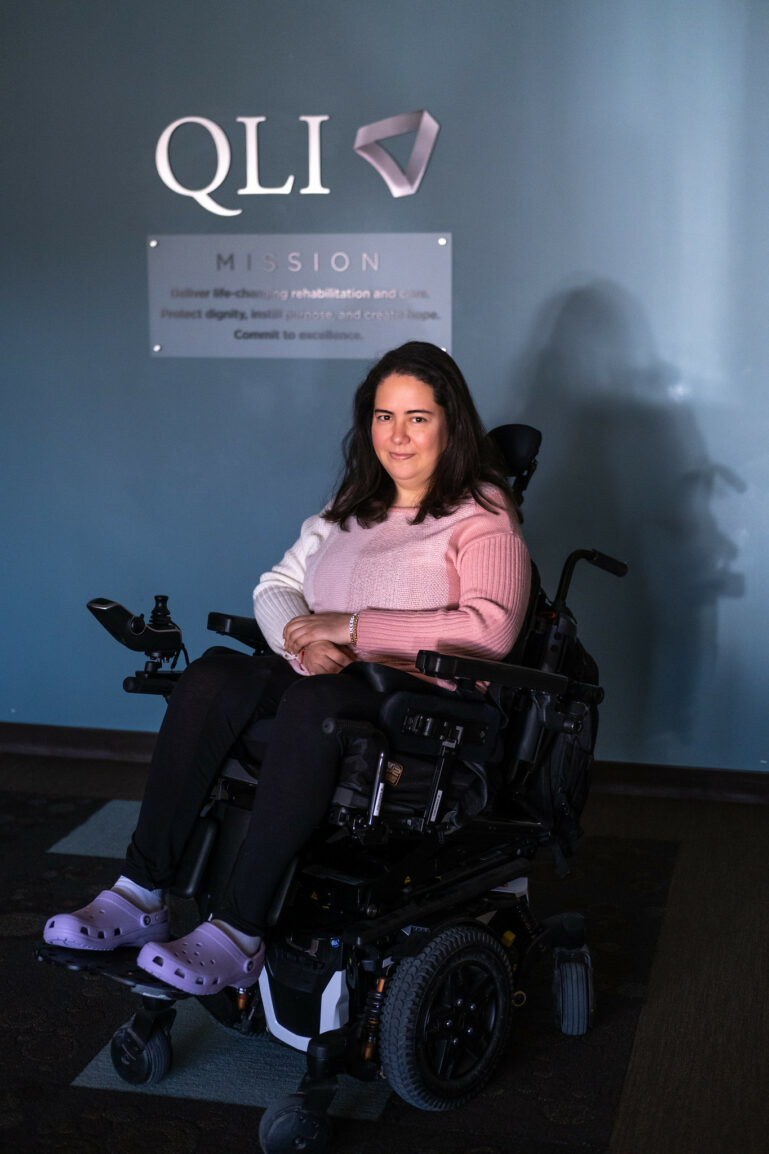“We’re going to be working on mindfulness in our meditation today,” says QLI Life Path Specialist Jaime Johnson. He pushes a button on his phone and a gong sound issues from it.
“Now,” he inhales slowly. “Close your eyes…”
Across the room, Melina Sanchez moves her powered chair into a full tilt. She is nearly at a ninety-degree angle, with her legs and feet fixed above her. She looks forward to these sessions, a chance to both relax and refocus attention to the present—who she is, how she got here, and where she will be in just a few short weeks.
Melina is an advocate for herself. She began her career in Washington, D.C, representing groups from the Los Angeles area and advocating for positive social policies. After five years, Melina worked in Los Angeles, before going back to D.C. This trade in job location happened quite a few times, being pulled from one coast to the other.
“Mediation has always been part of my life,” Melina says later on. “The opportunity to take ten minutes out of the day and reset is essential.” Over the preceding few weeks, Johnson has introduced Melina to a variety of breathing methods and periods of guided meditation. During this time, Melina has truly found peace amid her recovery, personified during these sessions with Johnson. Even for just ten minutes, everything else fades.
For Melina, this space in between the focus and the breathing centers her to all that surrounds her. From this, she rises.
THE ROAD TO QLI
On the heavy freeways outside of Los Angeles, so many people commute into and out of the city. For some, it is simply home, and these freeways and interchanges are the facilitators to and from work. Around 400,000 vehicles travel the 405 every day. It is difficult to comprehend the cars flitting by you, each transporting a person with their own world, their own desires, motivations, successes, and shortcomings. Yet, in the blink of an eye, no matter how cliché the phrase, these trajectories may be upended. Melina is one of these worlds. She left the 405 that day with a complete spinal cord injury and the loss of her ability to walk.
…
Contrast the density of Los Angeles to the open air of the Rocky Mountains and Colorado. Blue spruce, Douglas fir, and pine trees abound, Colorado is simply freedom and space. The little town hideaways may draw in people from cities like Los Angeles, but for a much different purpose, one that is a reward for the soul and a beacon for mindfulness. Colorado is an environment not beholden to a system that never sleeps or stops—Colorado takes its time.
Craig Hospital in Colorado is representative of this environment. Following her injury, Melina came east along the mountains to Craig. The great and leading national reputation preceded Craig and allowed Melina to have the proper time to heal. She had friends in the Denver area as well. This, combined with the focus of Craig and the locale of Colorado, meant that Melina was placed along a solid road to recovery. When the time came, Melina prepared to come to QLI at the recommendation of Craig.
DETERMINATION IN HER PROGRAMS
In just a little over a month, Melina became adept at slide board transfer, eagerly discussing with Physical Therapist Anna Calgaard the possibility of owning both a manual chair and a powered chair. In the Colladay Center gym Melina practices the slide board transfer into a manual chair. Through a 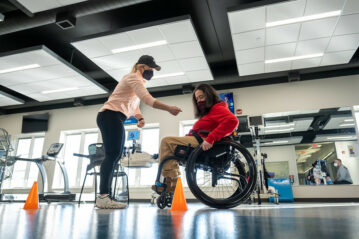
“The power chair is my day-to-day option for getting around. I am able to go longer distances but most people don’t have a vehicle that could accommodate a power chair so I wouldn’t be able to go on short trips with friends or family. Having a manual chair in that situation would make all the difference. Same applies for plane travel – a manual chair is much simpler.”
In the manual chair, Melina makes a few laps around the Colladay Center. “This is a workout,” she says, smiling. “Maybe I should have rescheduled my weights session that’s right after this.”
…
For many of her therapy sessions at QLI, Melina wears a stark red hoodie with the words
Love.
Culture.
Power.
all in bright white letters, one after the other, along the front. These are a tell-tale indicator of the fierce 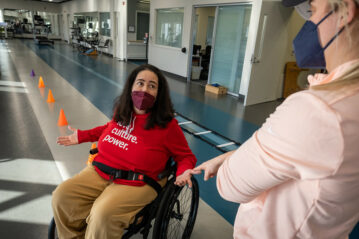
Jaime Johnson’s role as a Life Path Specialist corresponds to affirming Melina’s power. His sessions with her are all about helping Melina rebuild her life outside of therapies and the gym. If she wants to get out and explore nature, they do so. Johnson is a supportive ear if she just needs the time to have a heart-to-heart conversation. For one of their sessions, before their usual meditation time, Johnson provides support for Melina as she writes up a grant application with the Travis Roy Foundation. Roy, a former ice hockey player, was injured early on in his college career. The Foundation awards funds to individuals with spinal cord injuries, aiding them in purchasing equipment or chairs. The way that many of the questions are formatted speaks directly to Melina’s character of advocacy.
“How has your spinal cord injury changed your ability to work, socialize with friends and family, and live an independent life?”
“How will the equipment and modifications you are applying for improve your daily life?”
Melina pauses for some time, considering her responses. How will a new chair not impact her life? She describes her answer to Johnson, who types out the response into the application. Having the resources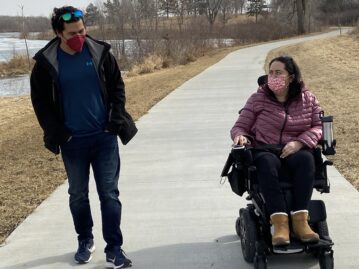
WHAT COMES NEXT?
Post-discharge, it is back to the mountains—to Colorado. Melina enjoys the fortune of having close friends in the Denver area. From the impression formed while she was at Craig, Colorado is an accessible place, one that could be warmer and welcoming of a return than should she discharge to California.
In a conversation, her attention is pulled to those freeways of the Los Angeles area. The congestion, the speed, and the temperament serve as a reminder of pain for her. The smog-cluttered area is not ideal for her anymore. Colorado holds a promise of potential and growth, where the mindfulness and reset that a day’s quick meditation can provide is personified. For Melina, something that has transcended her injury is a love of nature and being in it.
…
Melina and Exercise Assistant Sam Warneke have been tackling the issue of bed mobility for a couple of weeks. After Melina initiates and completes the slide-board transfer from her powered chair onto the bed, her hips are skewed slightly to the right—off center with the rest of her body. Mariah Carey is on in the background—Melina’s Alexa device acting as a master of ceremonies. They debate a little bit on which method would be best to center the hips. Melina’s bed can raise slightly—hinging fully on the middle of the bed—raising the head up towards the middle at a 90 degree angle. They try this a few 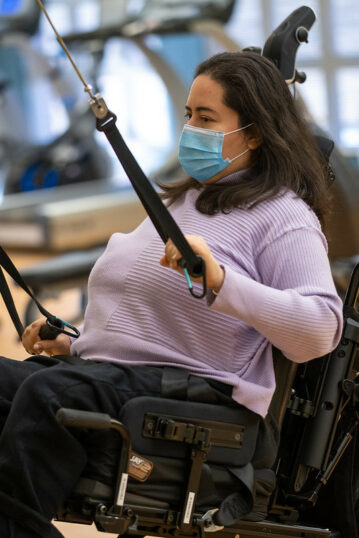
Both she and Warneke understand that this accomplishment means an easier transition towards living with some daily care and assistance. The more independent she can get in the routines, she will require less assistance. In some respects, the centered hips are a focal point of progress. To the outside observer, this may seem like a minimal breakthrough, but it personifies Melina coming into her own. The repetitions in the sessions with Warneke, Calgaard, and others are the catalyst towards this end result.
CONFIDENCE AND CONTROL
“You know, I’ve wanted to take some portraits of clients in their element,” says QLI Director of Creativity Jon Pearson. “There’s only so much one convey or see with their masks on. I need to capture them as they are.”
It is late on a Sunday afternoon. Though the weather outside is magnificent for mid-March, total relaxation is not on Melina’s mind. In less than a day, she is set to discharge to Colorado. Before leaving, she agrees to do a portrait as she is and in her element.
What all can be encapsulated in a single shot? Is it as simple as the phrase ‘a picture is worth a thousand words,’ or is there more to it than that? The time Melina has spent at QLI has all been in preparation for her life beyond. Her life before the injury was defined by advocacy for others amidst a congested environment. Now, she will be an advocate in an environment that is inherently more freeing.
Even in this portrait, without the presence of the aforementioned hoodie, all three single-word sentences ring out to close her time on campus.
Love. – A love for all new experiences and challenges. There is no setting the limit for what lies ahead.
Culture. – A respect and care for those of all backgrounds and viewpoints. All are welcome to guide and perfect the voice of the voiceless.
Power. – The power to rise above any challenge that may come her way.
“In a way,” she says. “I’ll continue to be an advocate even after I leave QLI.”
“As an SCI survivor—I can advocate for even more people now.”
Categories: Client Story, Spinal Cord Injury

